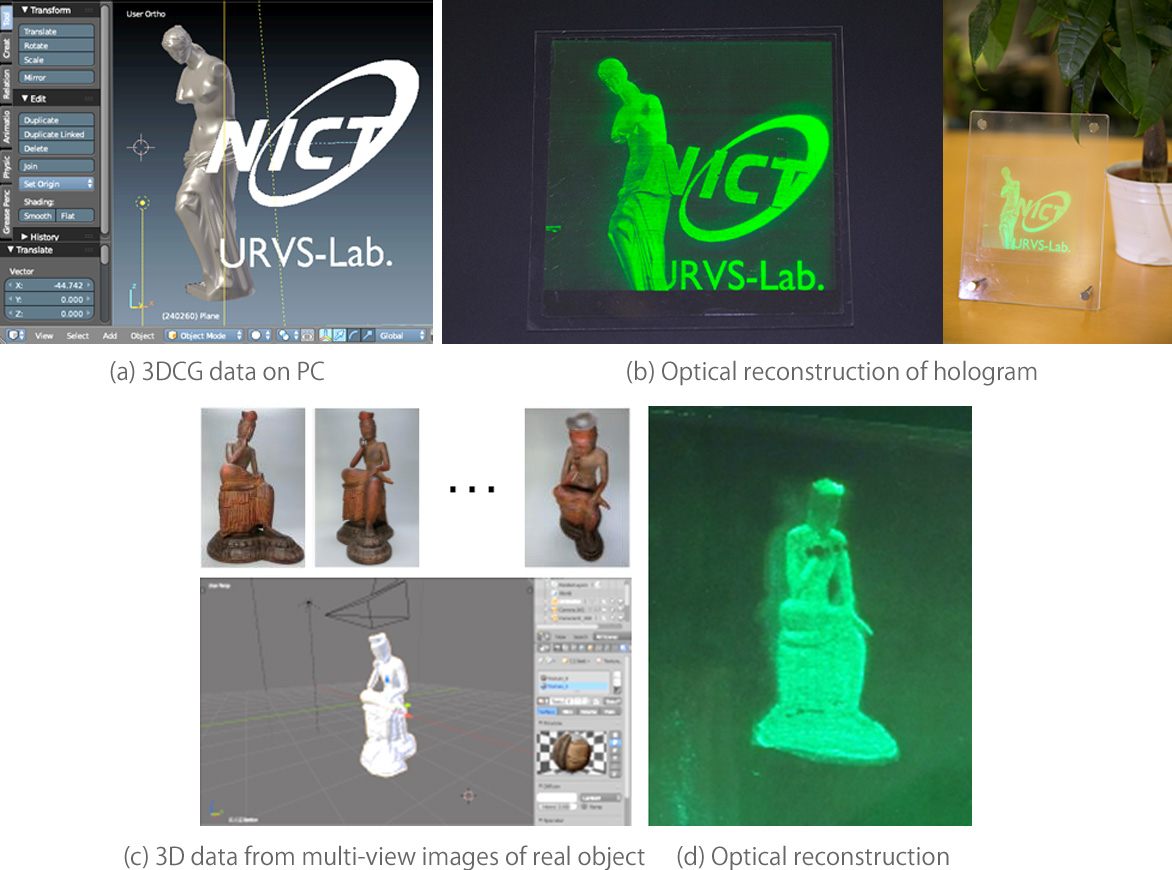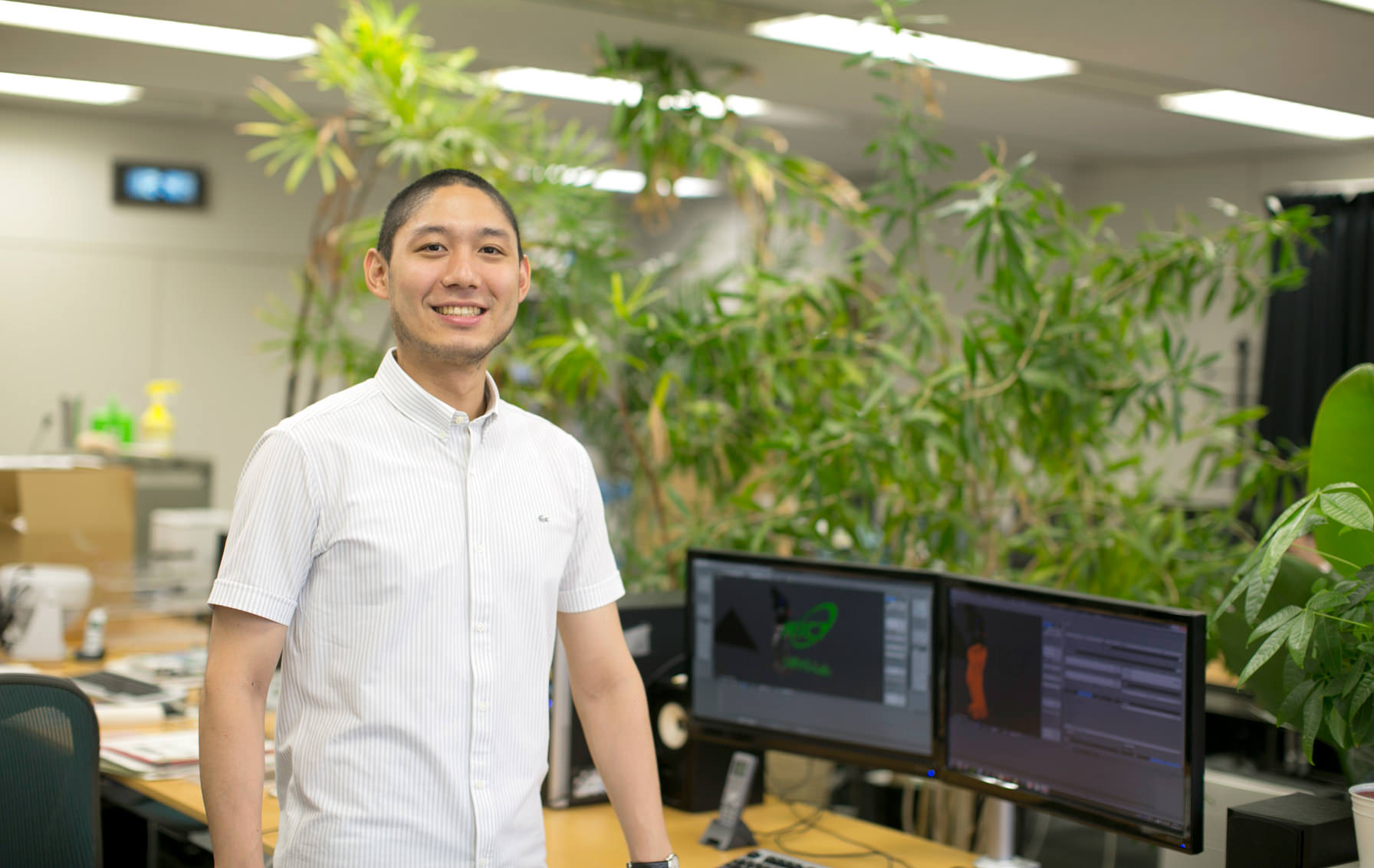
Senior Researcher
WAKUNAMI KokiPh.D. (Engineering)
After completing a doctoral degree, joined NICT in 2013. He is engaged in research on electronic holography, computer-generated holograms, hologram printers, etc.
- Home
- Researchers
- WAKUNAMI Koki
HOPTECH (Holographic printing technology)
A future with holograms opened up by hologram printer
Introduction
The word “holography” might make you imagine the technique that produces “floating 3D images in the air” straight out of a science-fiction (SF) movie. Holography can reproduce a 3D image by freely controlling light, and therefore, many research groups/institutes are focusing on realizing holographic 3D displays. Since 2000, NICT has been conducting research on holographic 3D displays as “electronic holography” [see Fig. 1].
![Prototype of electronic holmraphy system[1]](/_assets/img/people/people_dio-wakunami_fig01.jpg)
Prototype of electronic holmraphy system[1]
Pixel number: 1,408 x 1,058
Color: Unicolor (Red)
[1] K.Yamamoto, et al., The Institute of Image Information and Television Engineers Technical Report (in Japanese), 32(14), 1-4, (2008)
![Electronic holography system with viewing zone angle expansion technique[2]](/_assets/img/people/people_dio-wakunami_fig02.jpg)
Electronic holography system with viewing zone angle expansion technique[2]
Pixel number: 7,680 x 4,320
Display size: 3.6 x 2.1 [cm]
Color: Full color
Viewing zone angle: 15 degree
[2] T.Senoh, et al., IEEE J. of Dis. Tech. Vol.7, No.7 (2011)
![Real-time capture & reconstruction electronic holography system[3]](/_assets/img/people/people_dio-wakunami_fig03.jpg)
Real-time capture & reconstruction electronic holography system[3]
Frame rate: 12 [fps]
Capture by integral photography
Real-time hologram calculation with GPU x 4
[3] Y.Ichihashi, et al., Optics Express, Vol.20, Issue 19 (2012)
![Electronic holography system by using multiple SLMs[4]](/_assets/img/people/people_dio-wakunami_fig04.jpg)
Electronic holography system by using multiple SLMs[4]
Pixel number: 15,360 x 8,640*1
Display size: 7.3 x 4.1 [cm]
*1 4K SLM X 16
[4] H.Sasaki, et al., Scientific Reports 4, 6177 (2014)
Fig.1. The history of electronic holography in NICT
We started the development of the “hologram printer” for printing out 3D data stored in a computer. The hologram printer has the potential to realize not only 3D photographs but also next-generation holographic optical elements. We call this research project “HOPTECH (holographic printing technology)”, and here, we introduce the current progress and future vision of this project.
Holography and HOPTECH
The Hungarian-British physicist Dennis Gabor invented “holography” in 1947. He was awarded the Novel prize in physics in 1971 for this invention. Generally, holograms are created by recording an interference pattern between two beams: an object beam, which propagates from a target 3D object/scene, and a reference beam, which propagates from the other side to a hologram-recording material. After recording the hologram, by illuminating the same light as the reference beam to the hologram, the object beam will be reproduced and the target 3D object/scene can be observed. This is why holography is well known as a 3D reconstruction technique. If an interference pattern recorded on a hologram can be changed temporally, a dynamic holographic 3D display can be realized. At NICT, we call this kind of technique “electronic holography” and have developed several systems by using high-resolution SLMs (spatial light modulators) at 4K (3,840x2,160 pixels) or 8K (7,680x4,320 pixels) [see Fig. 1].

Example of digitally printed hologram
The interference pattern to be displayed on an SLM is generally generated by simulating light propagation phenomena from 3D data to a hologram plane. Therefore, electronic holography can reconstruct the 3D contents of both 3DCG (computer graphics) objects/scenes and real objects obtained by 3D scanning techniques. However electronic holography requires a huge number of pixels to reconstruct hologram data; even an 8K SLM forms only 3.6 x 2.1 cm2 of a display size in our system case (see Fig. 1). To overcome the resolution limitation, we developed a “hologram printer” in which a target wavefront is divided in a tiling manner. Then, each tile is reproduced by electronic holography and recorded onto a giving area on a hologram-recording material to form a large composite hologram.
- Holography:
The technique to record and reproduce the light wave based on the interference and the diffraction of the light. - Hologram:
The media in which the interference pattern is recorded based on the theory of holography.
HOPTECH opens up a future of 3D pictures
Figs. 2(a) and (b) show an example of a hologram recording of virtual 3D data created by computer graphics (CG). It is clear that the CG object “Venus de Milo” could be successfully reproduced. The recording color is monochromatic green but a full-color recording will be implemented in the near future. Figs. 2(c) and (d) show the hologram printing process and the reconstructed hologram of a real wooden “Buddha” statue, respectively. In this case, 3D data was created by combining multiview images captured with a camera. Owing to the recent advances in “3D printer” technology, we now have several approaches to obtaining 3D data of real objects/people, and such 3D data can be printed into a hologram by the hologram printer. In the near future, HOPTECH may make it possible to print out “3D pictures” such as “3D wedding pictures”", “3D picture books”, and “3D advertising posters”.

Fig.2. Examples of 3D data recording & reconstruction
REFERENCE:
K.Wakunami, et al., “Wavefront printing technique with overlapping approach toward high definition holographic image reconstruction”, Proc. SPIE 9867,98670J (2016).
Fabrication of next-generation optical element
The hologram printer can print out not only 3D data for visualization but also an arbitrary optical function through the fabrication of a holographic optical element (HOE). We named the HOEs fabricated by a hologram printer DDHOEs (digitally designed HOEs), to be distinguished from general HOEs. Since DDHOEs have a higher degree of freedom of implementable optical functions compared with general HOEs, they have the potential to become next-generation optical elements to be used in a wide range of optical industry fields. Fig. 3 shows an example of fabricating a DDHOE that implements a reflection function to concentrate incident light to a designed focusing point. It is clear that a digitally designed optical function could be successfully implemented.

Fig.3. Example of fabrication of DDHOE
REFERENCE:
K.Wakunami, et al., “Projection-type see-through holographic three-dimensional display”. Nature Communications. 7, 12954 (2016).
One of the applications of a DDHOE is as a specially designed optical screen for a holographic projection technique. Fig. 4 shows the optical reconstruction results of our new system, a “projection-type holographic 3D display”. An observer can see a floating holographic 3D image via the see-through DDHOE screen. This system was achieved using two key technologies: digital holographic projection to increase the display size of electronic holography and a DDHOE optical screen, which is the same as that shown in Fig. 3, to reflect the light of a projected holographic 3D image to a target observation area. Now the target observation area is highly limited at the focusing point of the DDHOE screen, however, by realization of “multi-projection” or “target point scanning technique” to expand the observation area, this work will open up the field of real holographic 3D displays such as in-car head-up displays, smart glasses, head-mounted displays, and digital signage.

Fig.4. Projection-type holographic 3D display
REFERENCE:
K.Wakunami, et al., “Projection-type see-through holographic three-dimensional display”. Nature Communications. 7, 12954 (2016).
Future work
We are now addressing some research topics to enable the practical use of HOPTECH. One of the topics is the realization of full-color hologram printing. By using not only green but also red and blue lasers, holographic 3D images will be recorded in full color. Techniques of copying holograms are also being investigated to enable high-volume fabrication. The illumination technique of holograms is also an important issue, since holograms cannot demonstrate their full potential if the illumination condition is different from that of the reference beam used in the recording process. There are still major challenges to be overcome before HOPTECH can be used in a practical way. However, we will continue the research and development under the belief that HOPTECH will open up a bright future in our lives.

At the desk of the Digital Optics Laboratory
- Home
- Researchers
- WAKUNAMI Koki